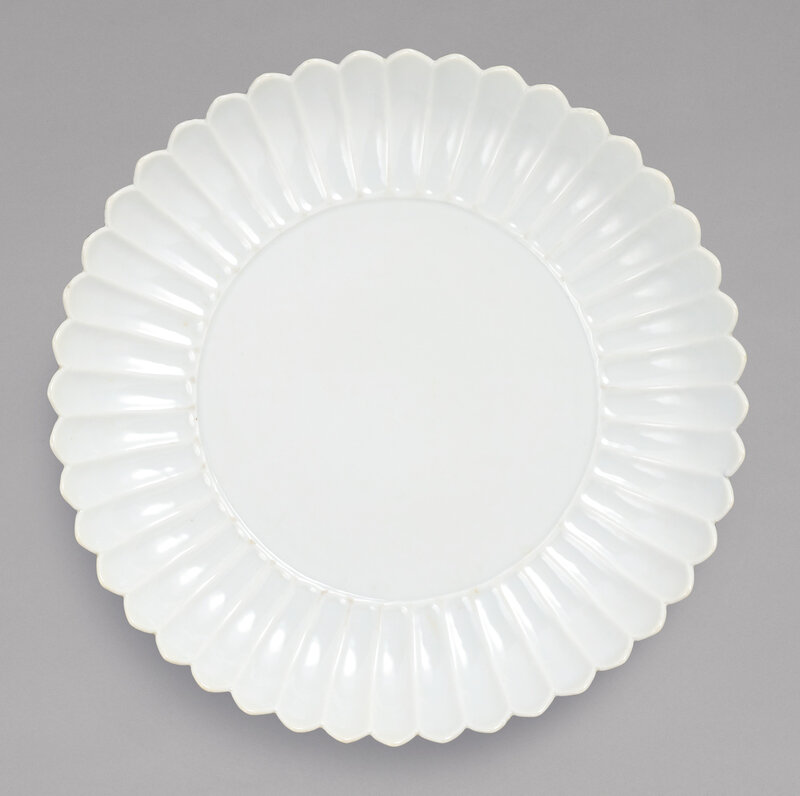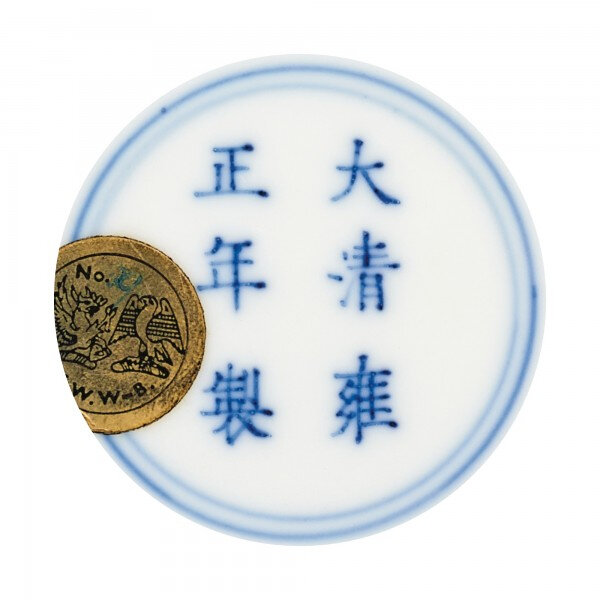the delicate shallow rounded sides exquisitely moulded in the form of slender fluted petals with pointed tips radiating from a slightly recessed flat centre simulating a chrysanthemum bloom, all supported on a foot of corresponding form, covered overall save for the footring and base with an even opaque white glaze, the base inscribed in underglaze blue with a six-character reign mark within a double circle.
Provenance: Collection of K.W. Woollcombe-Boyce.
Sotheby's Hong Kong, 24th May 1978, lot 185
Note: The form of the chrysanthemum dish was most probably inspired by earlier chrysanthemum-shaped wares, which were produced in a variety of different materials from as early as the Song dynasty. See a lacquer example attributed to the Song dynasty, included in the exhibition The Monochrome Principle. Lacquerware and Ceramics of the Song and Qing Dynasties, Museum für Lackkunst, Münster, 2008, cat. no. 13, together with a moulded Ding chrysanthemum dish, cat. no. 14.
The Yongzheng Emperor is recorded to have commissioned Nian Xiyao, Supervisor of the imperial kilns at Jingdezhen, to produce chrysanthemum dishes in twelve colours, forty pieces of each. The commission is dated to the 11th year of the Yongzheng reign (1733) though no original complete set of twelve dishes is preserved and Yongzheng period chrysanthemum dishes are known in many more than twelve colours. The Palace Museum, Beijing, has indeed published dishes covered in thirteen different tones, which have been assembled from different sources, and at least six further colours are recorded elsewhere. Hajni Elias in 'In the path of Tao Qian: "Chrysanthemum" wares of the Yongzheng emperor', Arts of Asia, May-June 2015, pp. 72-85, discusses the development of chrysanthemum-shaped porcelain wares in the Yongzheng period and suggests that they may reveal the Emperor's admiration for one of China's most famous poets, Tao Qian (365-427), a scholar-official known for his pastoral lifestyle and for having created the so-called 'farmstead poetry' (tianyuan shi) which was inspired by his chrysanthemum garden as well as the natural landscape and pastoral scenes. These themes were particularly relevant to the Yongzheng Emperor, who was an advocate of farming and manual labour.
See a related white-glazed example, included in the exhibition China. The Three Emperors 1662-1795, Royal Academy of Arts, 2005, cat. no. 172 (fourth row, right), probably the dish also illustrated in The Complete Collection of Treasures of the Palace Museum. Monochrome Porcelain, Hong Kong, 1999, pl. 257 (second row, right). Another similar example was sold in our New York rooms, 15th March 2017, lot 520.
Compare also dishes of this type covered in different glazes, for example the twelve dishes from the Palace Museum, Beijing, shown at the aforementioned Royal Academy of Arts exhibition; in this group, the teal-coloured example also showed a partly enamelled base; further, a pair of lavender-blue dishes from the Seattle Art Museum and T.Y. Chao collections, a bright turquoise-blue dish from the Paul and Helen Bernat and Hall Family collections, a celadon-green piece from the Leshantang Collection, and a purple dish from the Meiyintang collection, sold in these rooms, 19th May 1987, lot 279, 2nd May 2000, lot 553, 11th April 2008, lot 2503, and 8th April 2013, lot 4, respectively.
Sotheby's. Qing Imperial Porcelain A Private Collection, Hong Kong, 08 Oct 2019, 10:00 AM

/https%3A%2F%2Fprofilepics.canalblog.com%2Fprofilepics%2F1%2F0%2F100183.jpg)
/https%3A%2F%2Fstorage.canalblog.com%2F03%2F02%2F119589%2F96711876_o.jpg)
/https%3A%2F%2Fstorage.canalblog.com%2F11%2F31%2F119589%2F94773502_o.jpg)
/https%3A%2F%2Fstorage.canalblog.com%2F20%2F83%2F119589%2F94772815_o.jpg)
/https%3A%2F%2Fstorage.canalblog.com%2F26%2F72%2F119589%2F75604929_o.jpg)
/https%3A%2F%2Fstorage.canalblog.com%2F59%2F60%2F119589%2F26458628_o.jpg)




/image%2F1371349%2F20240422%2Fob_9e242e_telechargement-8.jpg)
/image%2F1371349%2F20240422%2Fob_389183_telechargement-2.jpg)
/image%2F1371349%2F20240418%2Fob_ac5c4c_telechargement.jpg)
/image%2F1371349%2F20240418%2Fob_709b64_304-1.jpg)